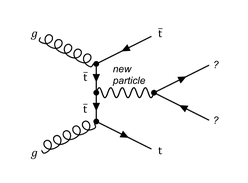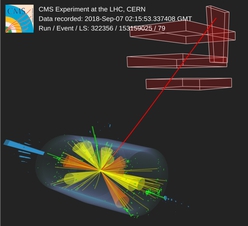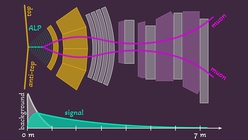Top BSM resonances
Searches for resonances with top quarks
Compact Muon Solenoid Experiment
Searches for resonances with top quarks

Example Feynman diagram for the production and decay of a new particle at the LHC in association with a top quark pair. (Photo adapted from CMS/CERN)
The search for new physics signatures has always been one of the important parts of the LHC physics program, and after the discovery of the Higgs boson in 2012 it is the main focus. The accelerator will run until 2040 at least, and any search for new physics requires an excellent understanding of the SM backgrounds in addition to an intimate knowledge of the behaviour of the very sophisticated detectors used to study the LHC collisions.
Our goal is to explore unused potential for new physics searches at the LHC, and focus on one of the gaping holes in considered signatures: additional, low momentum, particles being produced by the production of new physics in association with top quarks. We focus on the search for BSM particle decays into difficult to select objects making use of the presence of top quark pair production, focusing on exotic Higgs bosons and other BSM particles decaying to soft jets or leptons that may or may not be displaced and are produced together with top quarks. This approach aims to shed light on the question of the Dark Matter particles and/or the nature of the breaking of electroweak symmetry. Hidden-sector light particles may generate difficult to isolate experimental signatures at the LHC, such as low energy particles, lack of energy or displaced vertices. The list of signatures we focus on are low-mass and/or long-lived additional Higgs-like signatures with decays to jets or leptons. These signatures are directly connected to DM-inspired additional Higgs bosons.

Event display of the production of 4 top quarks in the CMS experiment. The large number of particle jets poses a challenge to reconstruct BSM resonances that are tackled with machine learning. (Photo: CMS/CERN)
Many models propose a focus on the existence of relatively low-mass particles that up to now would have evaded LHC searches just by the fact that they would have not been selected by the tight trigger requirements on those particles. The strategy normally is to reject the background from multijet production that is many orders of magnitude larger than the production rate of any interesting particles. Traditional exotic Higgs particle searches approach this challenge by using simple signatures and a very tight selection to aim to completely reject this background. After severe selection cuts, essentially a zero-background search is then performed, with backgrounds that are highly detector-driven, and as such is small, but also difficult to model as it relies on reconstruction artefacts that tend to be extremely rare and not well simulated. Selecting the events via the top quarks creates the opportunity to loosen requirements on the BSM decay products, the analogy is ttH production (but in this case, the particle is not the SM Higgs boson, and can be for example a supersymmetric Higgs boson partner or a scalar boson from DM Higgs portal models).
We use machine learning to provide sensitivity beyond simple selections. There are two important aspects here: use of machine learning for identification and reconstruction of leptons and jets; and reliable separation between background and signal on analysis level.
Another important tool for these searches is the identification of energetic top quarks. Here we work on improved algorithms to separate them from background by reconstructing in detail jet substructure.
Similarly, long-lived particles are one of the few signatures that have potential to grant access to BSM at the electroweak scale. The searches performed have up to now been very simple, one or two energetic displaced jets/leptons/tracks with increasingly tighter requirements mostly driven by the trigger at the LHC, and without considering the rest of the activity in the event. This approach means soft displaced objects are typically challenging to select as there are no viable triggers. On the other hand, most other BSM signatures that are not yet excluded at the LHC are much more complicated than just one or two objects, so to identify new particles other heavy particles are also present in the event.
On regular basis we offer bachelor, master and PhD students projects related to these topics.
For the most-up-to-date information on available positions and open projects, we encourage you to contact Prof. Dr. Freya Blekman and/or our CMS group leader.
